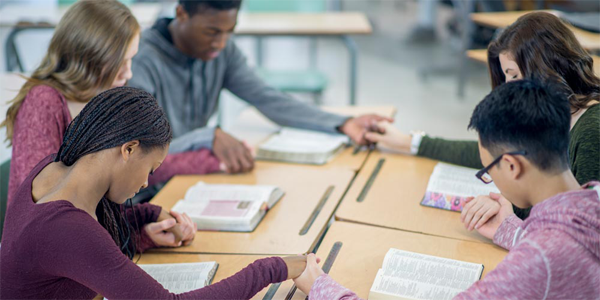
Momentum Grows to Protect Religious Freedom in Public Schools
Written by Jorge Gomez
First Liberty’s landmark U.S. Supreme Court victories in our Coach Joe Kennedy and Treat Children Fairly cases continue bearing fruit.
Thanks to these wins, our legal experts predicted this would be a school year with more religious liberty than ever before. By God’s grace, our prediction is turning out to be true. Multiple states are moving to protect religious liberty in schools.
For decades, public school districts often misunderstood their obligations under the First Amendment. Many school board officials thought religious expression was forbidden on government property. Like Coach Kennedy, countless public employees were censored from expressing their religious views. Many were even punished or forced to choose between their job and their faith.
While government cannot and should not coerce any citizen toward religion, it also cannot and should not inhibit religious freedom and expression. Government told countless teachers, coaches and administrators to keep their faith hidden for many years. But after our two Supreme Court victories, there’s a shift happening regarding religious expression our country.
Kentucky Governor Andy Beshear recently signed into law a bill that helps protect the rights of public employees. House Bill 547 states that school districts “shall not punish or prohibit an employee from, or punish an employee for, engaging in private religious expression otherwise protected by the First Amendment to the United States Constitution.”
Kentucky’s newest law isn’t a coincidence. It’s the result of the biggest positive change for religious freedom in more than 50 years, generated by our Supreme Court victories. These wins are helping states get back to the Constitution and its original intent for public religious expression. The law is finally being changed to reflect a more historically accurate reading of the First Amendment.
The robust protections in the law allow public employees to:
- Discuss religion and share religious materials with other employees in the same manner that employees are allowed to engage in nonreligious expression and discussions.
- Gather with their peers for prayer or religious study during lunch breaks or after school.
- Sponsor student religious clubs and organizations.
- Wear religious clothing, symbols or jewelry.
- Decorate their desk and personal spaces with items that reflect their religious beliefs.
Kentucky isn’t alone. A Florida school board unanimously approved a measure to commemorate the National Day of Prayer in Miami-Dade public schools—which also prompted board members to ensure Florida’s motto, “In God We Trust,” be displayed in the school board room. Last fall, a federal district court also upheld the constitutionality of the “In God We Trust” motto in Tennessee schools.
Cambridge Public Schools established sacred spaces at each campus for students and staff to practice regular religious prayers, becoming the first public school district in New England to do so. The Oklahoma State Superintendent of Public Instruction announced he will form a new committee to protect students’ right to prayer and worship in public schools.
Alabama is considering a bill that would allow students to pray in public schools using the microphone and broadcast address system. That legislation also states that no board of education or association in the state “may prohibit, impede, or deter a student-initiated and student-led voluntary prayer.”
The Idaho Legislature recently passed House Bill 182, which protects public school employees’ right to pray at times when they are free to engage in personal conduct. The bill’s text references the Supreme Court’s precedent set by Kennedy v. Bremerton School District. It is pending a signature from the Governor.
Montana legislators are also debating legislation to enshrine protections for religious expression in public schools. These proposals state that “any teacher, principal, or superintendent may open the school day with a prayer,” and clarify that students are free to initiate and participate in conversations “about religion with another student or teacher.” It would also permit prayer on school grounds and at school-sponsored events.
Texas is considering a bill that would allow parents to use up to $8,000 in public funds, per student, to pay for private schooling—including religious schools—through an educational savings account. Similar proposals have been introduced in Arkansas, Florida, Idaho, Kansas, Missouri, New Hampshire, North Dakota, Oklahoma and Tennessee, according to this report.
Fighting for What Matters Most in Our Nation’s Schools
We’re witnessing incredible momentum for religious freedom in our nation’s schools. But there’s still a lot of work ahead to ensure school districts, courts and officials across the country follow the Supreme Court’s direction.
Right now, we’re preparing to argue our Prayer Out of Bounds? case involving Cambridge Christian School at the U.S. Circuit Court of Appeals for the Eleventh Circuit. The argument is set for June 26th.
The case deals with two private Christian schools that competed for a state championship in 2015 at what was then the Citrus Bowl, now known as Orlando’s Camping World Stadium. The Florida High School Athletic Association prohibited them from using the city-owned microphone to pray before kickoff.
This is a huge case that could impact the freedoms and rights of students and religious schools across the country. If state officials can discriminate against Christian schools and prevent them from praying in public, it won’t be long before they find other speech to censor.
After decades of hostility, religious expression is being put back where it rightfully and legally belongs. But this battle is far from over, and we have tremendous opportunities right in front of us to build on our previous victories.













